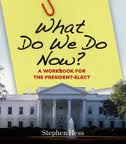As the Republican nominating process goes through its early contortions, serious thinkers should be looking ahead to the more daunting prospect ahead – governing.
Barack Obama is the weakest incumbent seeking re-election in more than 20 years. The Washington Post spells it out in detail today. That does not mean his defeat is certain, but the odds rarely get better for an opposition party.
So what are we doing to prepare?
The time honored tradition of waiting for a nominee, and then, very quietly and discretely exploring transition options for personnel and policy – so as not to look presumptuous – is a relic of another time.
There are three reasons for this. The first, and most important is a recognition of the times that we live.
The Bush-Obama transition was the first war-time transition since Johnson-Nixon, and occurred against the backdrop of economy-ravaging changes in global financial markets. Being staffed up and ready to move on Election Day is no long presumptuous in today’s world, but a prudent requirement for sound governance.
Second, consider that the first year for a new president is by far the most important of any Administration, and a key harbinger of overall success.
The election mandate is fresh, the political battle lines in Congress are more fluid, and the voters are more willing to entertain new approaches. The only way to truly capitalize on that momentum is an effective transition that has thoroughly mapped out policy and put in place the structure and processes for selecting experienced and capable appointees rapidly.
Reagan stands out as a model here, with a serious group of experienced officials setting up the apparatus of transition, and thinking through personnel, policy and roll out. George W. Bush, with only half the time due to the delayed election resolution, put together a truly first class organization to manage the transition with Vice President-elect Cheney in charge.
The success can be seen in the first year results. Reagan achieved his hallmark election promise to cut taxes and budget reform. Bush was even more successful, passing the bipartisan No Child Left Behind as well as the tax cuts that still bear his name.
In contrast, the three successful Democratic campaigns since the Vietnam War, Jimmy Carter, Bill Clinton and Barack Obama, were unsteady and ill-prepared for governance.
Carter’s insular Georgia mafia was legendary in its lack of preparation. Clinton’s attempted too much in too many places without strategic direction. And the Obama organization, despite its meticulous attention to detail in the campaign, and superb organization in the immediate transition, seemed to go off the rails once in power, in the truly crucial first weeks.
Those results had real world consequences.
Carter never recovered from his battles on Capitol Hill where he clashed with members of his own party.
Having run as a centrist, Clinton’s first policy foray inexplicably was to repeal the ban on gay personnel serving in the military, a fiasco that created an unnecessary distraction, and threatened Clinton’s moderate facade.
For President Obama, his first year will always be defined by passage of the $800 billion Stimulus law, and then the perplexing pivot to health care while the economy was still the top priority for average Americans.
Third, in the new 24/7 news cycle, the ability to move, shape and marshal public opinion to achieve goals moves at light speed. A transition needs to keep up or lose the narrative.
The day after the 1992 election, Bill and Hillary Clinton decided on a few days of down time after the exhausting pace of the campaign. While completely understandable, the mini-story line was one of a new President-elect mired in inaction. Could you imagine that kind of candidate posture in the era of Twitter?
Controlling the narrative of the transition is crucial to governing. To create a roll out that is seamless, actionable and constructive takes time – far more time that the few weeks available after the election.
Republicans need to start now – one year before election day.
The GOP had deep pockets and a wide bench of thoughtful experienced officials. Someone needs to start thinking about and assembling the mechanics of governing by putting in place a structure that can be put at the disposal of the eventual Republican president to enhance the chance for early success.
We need an organization of matured ideas, processes and protocols that can be rapidly grafted onto the winning presidential campaign, an organization that will have done the leg work on the structure of governing, while the campaign focuses on winning the election.
The first requirement in such an organization is to marshal the collective talent of Republican appointees from the last three GOP administrations.
Yes, this is highly counter-intuitive at a time when most of America hates Washington and the “insiders.” But it a paradox in our culture that while no one would use a doctor to fix a transmission, everyone seems to believe that anyone from the outside can be a better appointee than anyone who knows there way around.
The fact of the matter is that Washington does have a pattern of operation that survives from Administration to Administration. Anyone who tries to take that on without understanding always loses valuable time and energy.
Reagan understood this. Carter, Clinton and to a lesser extent Obama, didn’t.
The results show.
Operations: reach out to former officials to tap their unprecedented expertise. No longer in power and without political equities, the unvarnished facts of mission, policy, personnel and regulation in their former positions will become apparent.
Ideally, these officials would form the nucleus of a highly experienced and knowledgeable “mobile operations group;” managers with unrivaled subject matter expertise that could be deployed rapidly in a transition to assess immediate issues and necessary personnel action, and also serve temporarily to monitor/manage agency or department affairs until new political management is confirmed.
Recruiting: concurrent to the operational element in planning, should be a serious effort to create a transparent and comprehensive set of processes and protocols to recruit political appointees.
The simple truth is that “personnel are policy.” Administrations will rise or fall on the quality of the people entrusted with high ranking government jobs. There are no shortage of former PPO officials from all Administrations that can provide candidate advice on what worked and what did not. Those former officials should be interviewed and their work catalogued.
While there is no taking the politics out of politics, it is entirely possible to improve the quality of appointments by seeking help from the professional recruiters whose day job is, after all, to find the best talent. In planning for a personnel office, room should be made for advice from professional recruiters to advice on process and criteria.
And as mundane as it sounds, there needs to be a world class computer system to manage the a prospective pool of political candidates.
A system that is not only accessible to the public in its ability to attract talent, but one that allows for the kinds of due diligence that is an unfortunate fact of life today with social media. It needs to be secure, but also interactive, so that Transition officials across functional lines will have the ability to review data on potential nominees.
A good place to start would be to interview the officials of large corporations and small start ups to understand the nature of their recruiting systems and adapt the most dynamic to a transition operation.
Operationally an early requirement (and determinant of success) of a recruiting operation will be the engagement of the eventual Republican nominee in identifying a cohort of potential appointees that would agree to background investigations that would begin after the nominating conventions. Such checks would not represent assurance of a political position, but rather would be designed to provide the president-elect with a wide body of pre-cleared officials whose nominations could be sent for confirmation as soon as the Senate is in a position to accept them.
Legal: with Operations and Recruiting, there needs to be a legal unit composed of two parts; agency/department general counsels or their immediate subordinates, and congressional legislative counsel, that can actually draft legislative language. This unit can assess the legal and regulatory structure put in place under the Obama administration and design specific legislative remedies with a scalpel instead of an ax. These efforts would serve as proxies for discussions with Congress once the new president is sworn in.
Needless to say, the key to any early legislative success will be careful, constant and courteous communication with key Members to ensure that the Administration is not blindsided and that its priorities are incorporated in legislative action.
Scheduling: finally, there needs to be a “tick-tock” function.
This group would break down the time period between Election Day and the 4th of July in the first year of a new Administration. The group would create a “skeleton” but comprehensive public messaging tracking calendar that would include holidays, congressional schedules, budget cycles, historic dates/anniversaries that would would guide the Administration as it roll out initiatives, policies, regulations and Executive Orders.
The brutal pressure of the news cycle and events beyond the White House’s control can rapidly overwhelm any Administration. Having a strategic plan to refer to, that can be adapted as necessary, will be an anchor “common denominator” providing a valuable counter-weight to day-to-day fights that can easily throw a young Administration off its game.
Altogether, this type of initiative would provide campaign management and the nascent transition team leadership with a tool to execute administrative planning beginning the day after the election, and carrying the team forward through the first crucial months as the new political team comes on board.
If properly executed, this type of organization would allow the new President to hit the ground running – literally, with almost immediate feedback on current operations, a planning tool for appointments and legislation, and the ability to quickly get a political team in place to execute the new agenda.
As every past President knows, winning the election is the easy part. Governing, both its frustrating limitations and its awesome possibilities, are rooted in the least sexy and most mundane functions of management. In politics they get short-shrift.
By assembling the wise-men now, by starting now, the potential for success down the road is materially enhanced.
Now, will anyone step up?

